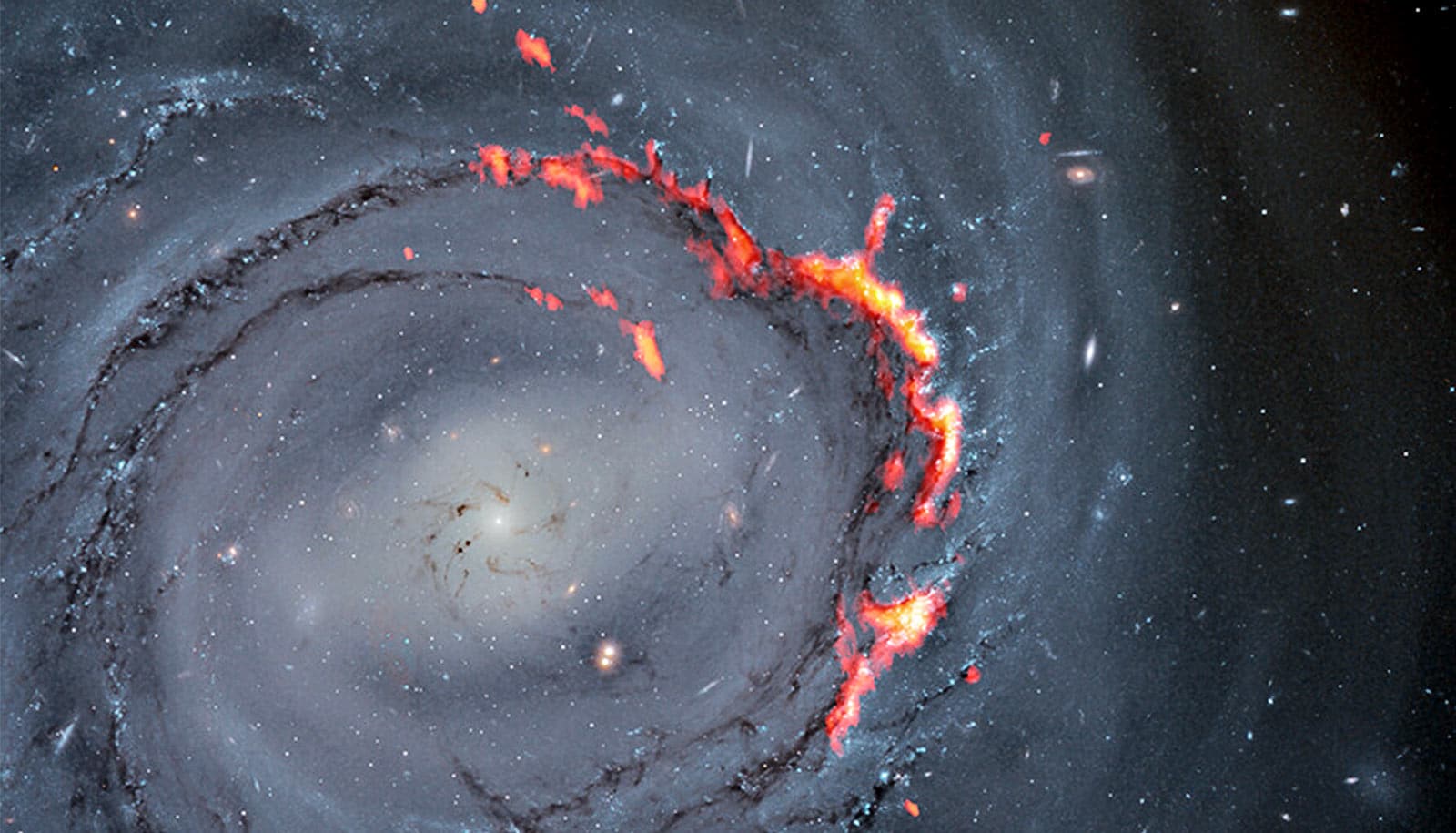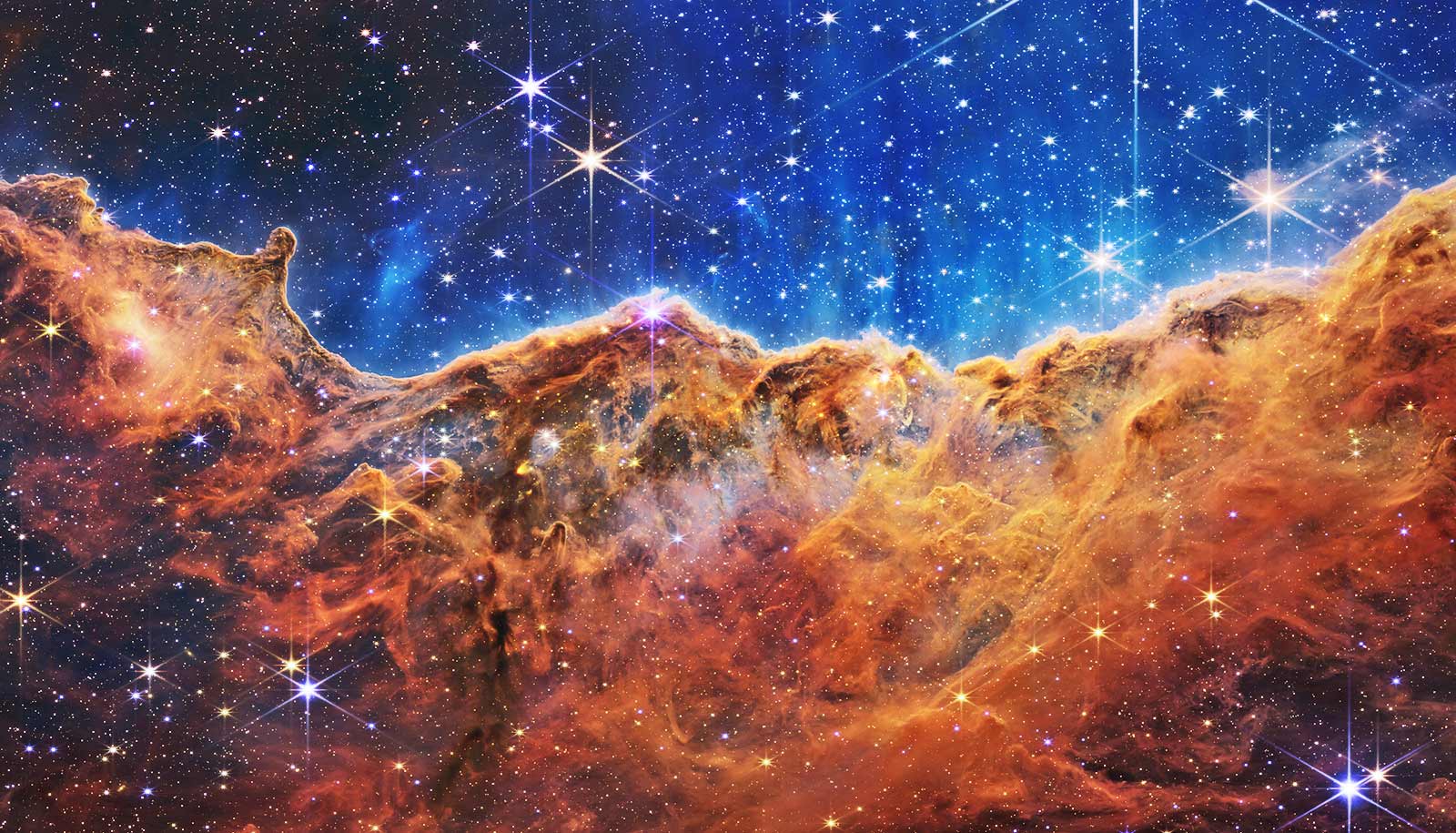
A zoomed in view of an ALMA (red/orange) and Hubble Space Telescope (optical) composite of NGC4921. This composite highlights filament structures resulting from the effects of ram pressure stripping. Ram pressure stripping is a process known to strip gas out of galaxies, leaving them without the material needed to form new stars. A new study indicates that some material may not be stripped away from the galaxy, and is instead, reaccreted, potentially with the help of magnetic fields, slowing down the process of galaxy death. (Credit: S. Dagnello/ALMA; K. Cook, L. Shatz/ NASA/ESA/Hubble)
‘Cosmic boomerang’ shines light on life cycle of a galaxy
The first observation of a cosmic boomerang effect offers new insights into how galaxies grow, live, and die.
Astronomers have for the first time observed a cosmic boomerang effect—streams of heavy, molecular gas that are stripped away from a distant galaxy only to circle back and return later.
Details of the discovery, previously theorized in simulations but not observed in detail, will appear in the Astrophysical Journal .
The observation offers new insights into the life cycle of a galaxy and the structural formations within galaxies, as traced by molecular gas. In particular, the research focuses on a process called ram pressure stripping, in which gas from galaxy clusters acts like a wind that strips away the star-making material inside a galaxy—hastening its demise.
“Astronomers are interested in studying how galaxies grow, live, and die,” says lead author William Cramer, who began the research as a graduate student at Yale University and is now a postdoctoral research scholar at Arizona State University.
“Effects like ram pressure that can speed up the normal galaxy lifecycle are very important to understand for this reason. Furthermore, the molecular gas in galaxies is the birthplace of new stars, and therefore studying the effect of ram pressure on it is of paramount importance.”
For the study, the researchers used the Atacama Large Millimeter Array (ALMA) radio telescope, located in northern Chile, to create a high-resolution map of dense molecular gas in the galaxy NGC 4921 as it experiences ram pressure stripping.
The map shows unusual structures that form in the ram pressure “wind”—long filaments of heavy gas connected to newly-forming stars. This dense, heavy gas is thought to be more resistant to ram pressure stripping, perhaps due to magnetic fields holding it more firmly in place.
“When an external force like ram pressure disturbs a galaxy, it offers an opportunity to learn about the internal forces that operate in galaxies,” says coauthor Jeffrey Kenney, a professor of astronomy at Yale. “The unusual filaments would not form without magnetic fields, so we also learn about the importance of magnetic fields in galaxies from this ram pressure interaction.”
The ALMA data clearly show filaments of molecular gas connected to galaxy NGC 4921—the filaments are, indeed, resisting. But then the researchers saw something else: Some of the previously-stripped gas comes back.
“Instead of being thrown out never to return, some of this gas is moving like a boomerang, being ejected but then circling and falling back to its source,” Cramer says. If this gas is recaptured into the galaxy, it can form new stars .
The boomerang effect is significant for several reasons, the researchers say. It provides hard evidence about the evolution of galaxies; it confirms a long-held theory about galaxy development; and it aids astronomers trying to predict the birthrate of new stars.
“The interstellar medium of galaxies is complex, with many variables that are hard to model,” Cramer says. “This observation is important because it shows that fallback of gas can be detected and allows us to search more broadly to help characterize it.”
Source: Yale University
The post ‘Cosmic boomerang’ shines light on life cycle of a galaxy appeared first on Futurity .
Share this article:
This article uses material from the Futurity article, and is licenced under a CC BY-SA 4.0 International License. Images, videos and audio are available under their respective licenses.
Related Articles:
What do the Webb Space Telescope images reveal?
July 19, 2022 • futurityMost isolated massive stars are ‘runaways’
Nov. 3, 2020 • futurityLinks/images:
- https://www.futurity.org/aztec3-galaxy-stars-801192/
- https://www.futurity.org/molecular-clouds-stars-2436582/
- https://www.futurity.org/galaxy-stars-telescopes-1314912-2/
- https://news.yale.edu/2021/07/29/catching-cosmic-boomerang-action
- https://www.futurity.org/galaxies-stars-space-2613762/
- https://www.futurity.org


